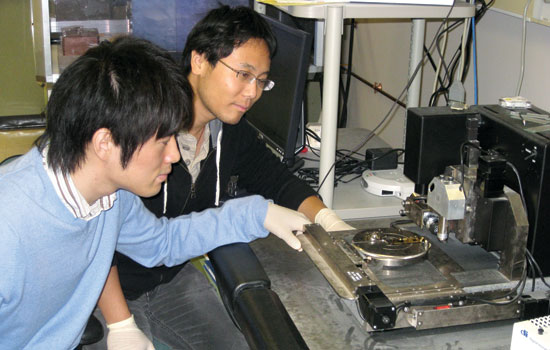RIT engineers use nature to enhance performance of micro devices
Submitted photograph
RIT graduate students Yusuke Takahashi, left, and Zhonghua Yao test a nano-fiber structure they are developing as part of a project to reduce particle accumulation in the channels of micro devices. The technology takes inspiration from the fibers of the lotus leaf which passively remove debris from the plant's surface.
When a drop of water or piece of debris lands on a lotus leaf it would appear to the naked eye that nothing unusual was occurring. However, if one were to look under a microscope, the surface of the leaf appears to spring into action.
Thousands of tiny fibers passively remove the water or debris from the plant, acting as a defense mechanism to keep the surface clean. The process is incredibly efficient, uses little energy and is mimicked by countless animal and plant species.
Now engineers at RIT are taking inspiration from this natural occurrence to create new nano structures that will improve the performance of a host of micro devices.
The research team is attempting to create nano fibers that can be placed in the micro- and nano-channels of microsystems, which are used to transfer fluid in these devices and are key components in the system’s operation.
Much like the surface of a lotus leaf, the technology will be used to passively remove particles that can build up on channel surfaces. The phenomenon, known as fouling, can contaminate experiments and reduce the efficiency of these devices.
“Fouling is a major impediment to the improvement of microsystem performance and efficiency,” notes Yen-Wen Lu, assistant professor of microsystems engineering at RIT and principal investigator on the project. “Through the development of this technology we hope to create a mechanism that passively removes these particles efficiently with little energy expenditure.”
Graduate students Yusuke Takahashi and Zhonghua Yao are currently working with Lu to design and test a nano fiber structure and hope to ultimately develop a mechanism with self-cleaning and anti-fouling capabilities that can be incorporated into numerous types of micro devices.
“This research seeks to enhance understanding of the fouling phenomenon while also developing a structure and fabrication method to solve the problem,” adds Lu. “The findings will assist in guiding additional research and enhance commercialization opportunities for anti-fouling mechanisms in biomedical applications.”
The project is in collaboration with San Francisco State University and is being funded through a grant from the National Science Foundation.













